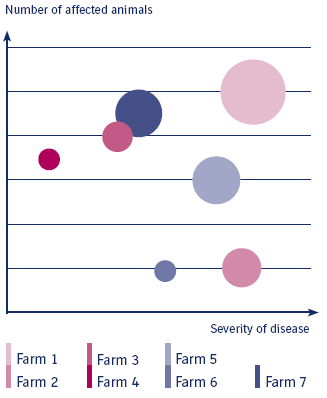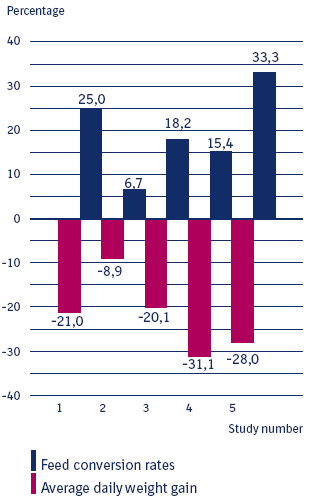2.3 What is the likely impact of Ileitis on farm economics?
The economic impact of an Ileitis infection depends on several circumstances. However, the economic margins are negatively affected in any case. The actual economic impact on a specific farm is influenced by the age and number of affected pigs and the severity of the disease (Figure 2.3 a).

Figure 2.3 a
The economic impact of Ileitis in relationship to the severity of the disease and the number
of affected pigs (the circle size is related
to the size of the economic impact) .
In some farms, a number of pigs may be found with mild or even undetectable clinical signs – typical for the chronic form. In farms with the acute form, usually a lower number of animals is affected but with more serious and often including fatal clinical signs. In both situations, the economic effects can be the same (e.g. farm 5 and farm 7 in Figure 2.3 a). Therefore, the economic impact of Ileitis depends rather on the specific farm situation than on the form of the disease (chronic or acute) alone.
Pigs affected with Ileitis suffer from poor growth, need an increased amount of feed per kg gain, show an increased percentage of lightweights and have often a higher mortality (McOrist and Gebhardt 1999). The relationship between these economic important traits produces a bottleneck for any pork producing system.
In a series of studies in England, McOrist inoculated several groups of pigs with cultures of Lawsonia intracellularis and produced Ileitis in weaned pigs, while leaving littermates in adjacent rooms unchallenged and unaffected (McOrist et al. 1997). Both groups of pigs (those with and those without Ileitis) were free of other diseases and fed an identical diet. This allowed the comparison of the exact effects of Ileitis without confusing factors involved. He repeated these controlled comparisons 5 times and the results are shown (Figure 2.3 b).

Fig. 2.3 b
The impact of Ileitis on average daily weight gain and feed conversion rates – Summary of five controlled challenge studies, showing the difference between control and challenged animals.
In these studies, the average weight gain of the challenged pigs was 8 to 31% less than the control pigs. Also the challenged pigs ate on average an extra 6 to 33% more feed per kg body weight gain.
Similar beneficial results were observed by Gogolewski and Cook in a well-controlled field study of growth and nutritional conditions among pens of grower pigs with or without naturally occurring Ileitis. The authors found that the daily weight gain was reduced by an average of 24% over the life of the Ileitis-affected pigs. The affected pigs were on a variety of diets, but this had no clear impact on the disease occurrence which had no outcome of the results.
Therefore Ileitis can be costly by preventing optimal growth and increasing the amount of feed per kg gain considerably.
© Boehringer Ingelheim Animal Health GmbH, 2006
All rights reserved. No part of this Technical Manual 3.0 may be reproduced or transmitted in any form or by any means, electronic or photocopy, without permission in writing from Boehringer Ingelheim Animal Health GmbH.




